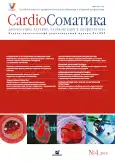Markers of subclinical atherosclerosis in the ten-year risk estimation of cardiovascular events
- Authors: Bovtyushko P.V1, Grishaev S.L1, Filippov A.Y.2, Obrezan A.G2
-
Affiliations:
- Medico-military academy named after Kirov
- Saint-Petersburg State University
- Issue: Vol 6, No 4 (2015)
- Pages: 12-16
- Section: Articles
- URL: https://journals.rcsi.science/2221-7185/article/view/45158
- DOI: https://doi.org/10.26442/CS45158
- ID: 45158
Cite item
Full Text
Abstract
Full Text
##article.viewOnOriginalSite##About the authors
P. V Bovtyushko
Medico-military academy named after Kirovд-р мед. наук, преподаватель каф. военно-морской госпитальной терапии ФГБВОУ ВПО ВМА им. С.М.Кирова 194044, Russian Federation, Saint Petersburg, ul. Akademika Lebedeva, d. 6
S. L Grishaev
Medico-military academy named after Kirovзам. начальника каф. военно-морской госпитальной терапии ФГБВОУ ВПО ВМА им. С.М.Кирова 194044, Russian Federation, Saint Petersburg, ul. Akademika Lebedeva, d. 6
A. Ye Filippov
Saint-Petersburg State University
Email: cardioclinik@list.ru
д-р мед. наук, проф. каф. госпитальной терапии медицинского фак-та ФГБОУ ВПО СПбГУ 199034, Russian Federation, Saint Petersburg, Universitetskaia nab., d. 7/9
A. G Obrezan
Saint-Petersburg State Universityд-р мед. наук, проф., зав. каф. госпитальной терапии медицинского фак-та ФГБОУ ВПО СПбГУ 199034, Russian Federation, Saint Petersburg, Universitetskaia nab., d. 7/9
References
- European guidelines on cardiovascular disease prevention in clinical practice. Eur Heart J 2003; 24: 1601-10.
- Expert Panel on Detection, Evaluation, and Treatment of High Blood Cholesterol in Adults. Executive summary of the third report of the National Cholesterol Education Program (NCEP) Expert Panel on Detection, Evaluation, and Treatment of High Blood Cholesterol In Adults (Adult Treatment Panel III). JAMA 2001; 285: 2486-97.
- Rodgers A, Ezzati M, Vander Hoorn S et al. Distribution of major health risks: findings from the Global Burden of Disease study. PLoS Med 2004; 1: e27.
- Ajani U.A, Ford E.S. Has the risk for coronary heart disease changed among U.S. adults? J Am Coll Cardiol 2006; 48: 1177-82.
- Рогоза А.Н. и др. Современные методы оценки состояния сосудов у больных артериальной гипертонией. М.: РКНПК, 2008.
- Stein J.S, Korcarz C.E, Post W.S. Use of Carotid Ultrasound to Identify Subclinical Vascular Disease and Evaluate Cardiovascular Disease Risk: Summary and Discussion of the American Society of Echocardiography Consensus Statement. Prevent Cardiol 2009; p. 34-8.
- Catapano A.L, Reiner Z, De Backer G et al. ESC/EAS Guidelines for the management of dyslipidaemias. The Task Force for the management of dyslipidaemias of the European Society of Cardiology (ESC) and the European Atherosclerosis Society. Atherosclerosis 2011; 217S: S1-S44.
- Taylor A, Merz C, Udelson J. Executive Summary - Can Atherosclerosis Imaging Techniques Improve the Detection of Patients at Risk for Ischemic Heart Disease? J Am Coll Cardiol 2003; 41 (11): 31-7.
Supplementary files







